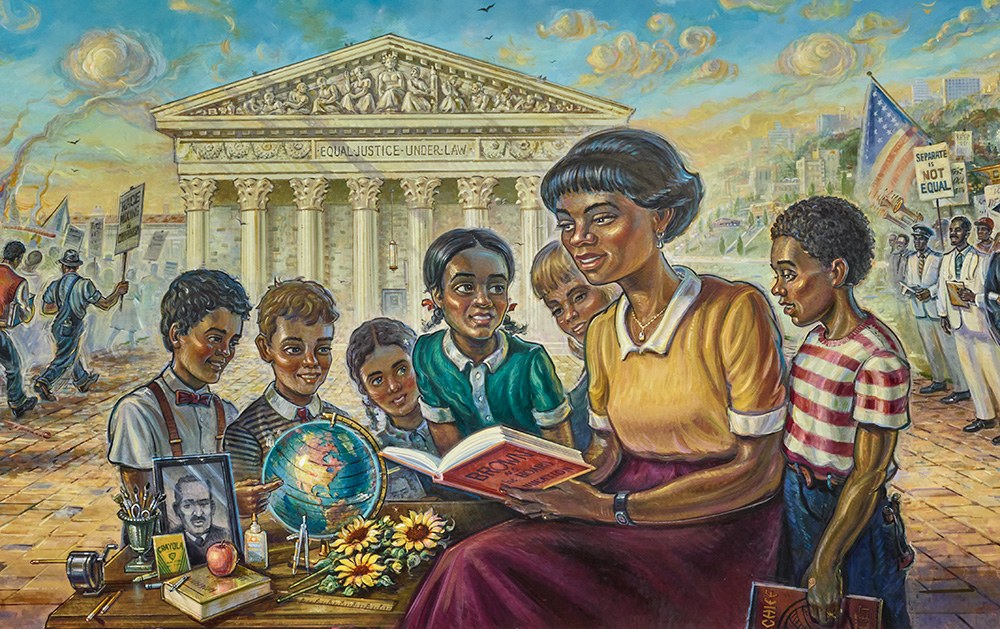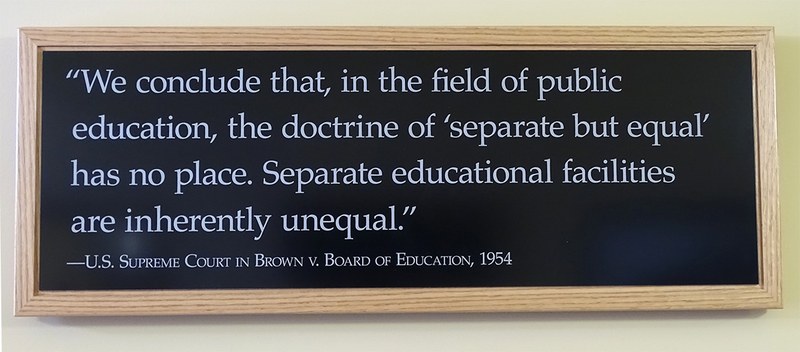Posted: May 16, 2024
The Brown v. Board of Education ruling permeated most sectors of American life, from education to housing to economics, but the legacy of the ruling is complex. As educators reflect on this 70th anniversary, it seems clear that we are still striving to realize the core promise of the Brown ruling: educational equity.

Brown v. Board of Education mural by artist Michael Young, located inside the Kansas Capitol in Topeka depicts the legacy of the 1954 landmark U.S. Supreme Court desegregation case that had its roots in Topeka. Photograph by Highsmith, Carol M., https://www.loc.gov/item/2020741744/.
In the winter of 1951, 8-year-old Linda Brown walked two chilly miles and crossed active train tracks to reach her school in Topeka, Kansas. Although her father tried to enroll her in a school closer to their home, Linda was denied access and told it was for white children only.
The lawsuit that followed, led by the NAACP (National Association for the Advancement of Colored People), eventually reached the United States Supreme Court, where it left its mark on history by challenging segregation, the notion that "separate but equal" provided fair education. Brown v. Board of Education combined five cases from different states, representing over 200 Black and Brown children (Legal Defense Fund, 2024).
Part of the testimony heard by the Supreme Court came from Dr. Kenneth Clark, whose pioneering research in collaboration with Dr. Mamie Phipps Clark showed the effects of segregation on children ages 3 to 7 years old.
In May of 1954, the Supreme Court cited Dr. Clark's research and testimony when they made their decision, explicitly noting that "To separate Black children from others of similar age and qualifications solely because of their race generates a feeling of inferiority as to their status in the community that may affect their hearts and minds in a way unlikely ever to be undone" (National Archives Catalog, 1954, p. 494).
The Court decided unanimously that "separate but equal" was inherently unfair and unlawful. The ruling overturned the legal footing of racial segregation and helped to spark the Civil Rights Movement of the 1950s and 60s.

The legacy of Brown v. Board of Education extends far beyond the courtroom
The Brown v. Board of Education ruling permeated most sectors of American life, from education to housing to economics, but the legacy of the ruling is complex. For instance, when we, as educators, reflect on this 70th anniversary, it seems clear that we are still striving to realize the core promise of the Brown ruling: educational equity.
Segregation was and continues to be a significant driver of inequality, impacting resource allocation, opportunity, and family and child outcomes related to health, education, and economic advancement (National Academies of Sciences, Engineering, and Medicine, 2023).
It is crucial for us, as early learning professionals, to know that segregation is not a problem confined to K–12 education. The residual impact of discriminatory housing and economic policies continues to impact our communities and the children, families, and educators who call them home.
Recent studies show that early learning programs mirror society's racial and economic class divisions, leading to inequalities in learning outcomes, funding and resources, access to high-quality programming, access to highly trained educators, and more.
The reality is that many preschool-age children across all racial and ethnic backgrounds attend schools with high concentrations of same-race students (Piazza & Frankenberg, 2019), and on average, preschool programs nationwide are more segregated than kindergarten and first grade (Peiffer, 2019). It is noteworthy that although integration may be higher at kindergarten and first-grade levels, it is still rare.
It is equally important that we know the research findings of Drs. Mamie and Kenneth Clark have been reproduced several times in the past eighty years and have shown the same results. Thanks to their research and testimony, we know that the roots of racial bias form during children's earliest years, making our early learning programs an essential place for addressing—or exacerbating—issues of diversity, equity, and inclusion (Peiffer, 2019).
Moving forward with purpose
Pursuing educational equity requires a multi-sided approach that addresses inequities in systems, promotes diversity and inclusivity, and ensures access to high-quality early childhood education for all children, regardless of race, ethnicity, ability, or socioeconomic status.
Within our programs every day, we can work to:
- promote culturally responsive teaching practices
- address implicit bias and discrimination
- promote equitable policy and practices
- engage families and communities in the educational process
- diversify our workforce
- create program cultures and climates where diversity thrives
- pursue professional education and help each other navigate the process
- advocate for fairer systems
We have become torchbearers. It is our turn to move the field of early care and education closer to the promise of the Brown ruling by fostering the vibrant, diverse learning communities children need for success both now as learners and in the future as adult members of a multiracial, multilingual, multicultural society.
Seventy years have passed, and although state-sanctioned segregation has long been unlawful, segregation itself has not faded into history. We still have work to do. Let us keep pushing for positive changes in our programs, schools, and communities so every child can reach their full potential.
BKC courses
If you are wondering what action steps you can take toward education equity, Better Kid Care offers an array of courses that can help you get started:
Self-awareness and personal bias:
- Antiracism (Part 1): Self-awareness and Communication (course)
- CLAD – Cultural, Linguistic, Ability Diversity – Are you self-aware? (article)
- Cuidado Infantil Familiar: CLAD – Diversidad Cultural, Lingüística, y de Capacidades (Curso de español)
- Cultural Diversity and Responsiveness in Early Childhood Education (course)
- Family Child Care: CLAD – Cultural, Linguistic, Ability Diversity (course)
Program policy and workplace climate:
- Antiracism (Part 2): Program Policy and Family Engagement (course)
- Positive Work Environments Where Programs and Educators Thrive! (course)
- Social-Emotional Learning and Equity: Program Policy (course)
Culturally responsive teaching practices and learning environments:
- Antiracism (Part 3): Culturally Responsive Teaching (course)
- Antiracism (Part 4): Physical and Emotional Environments (course)
- Fostering Community Through Restorative Practices (course)
- Observación con Propósito: Enfoque en la Equidad (Curso de español)
- Observation with Purpose: Focused on Equity (course)
- Social-Emotional Learning and Equitable Practice for ECE Professionals (course)
- Window, Mirrors, Sliding Glass Doors – How Diverse is Your Bookshelf (mini lesson)
References:
National Archives Catalog. (1954). Brown v. Board of Education of Topeka, Opinion; May 17, 1954. Records of the Supreme Court of the United States.
Legal Defense Fund. (2024). Brown V. Board of Education. Retrieved April 2024.
National Academies of Sciences, Engineering, and Medicine. (2023). Closing the Opportunity Gap for Young Children. Washington, DC: The National Academies Press.
Peiffer, E. (2019, October). Segregated from the Start: Comparing segregation in early childhood and K–12 education. Retrieved April 2024.
Piazza, P., & Frankenberg, E. (2019). Segregation at an Early Age 2019 Update. Retrieved April 2024.

